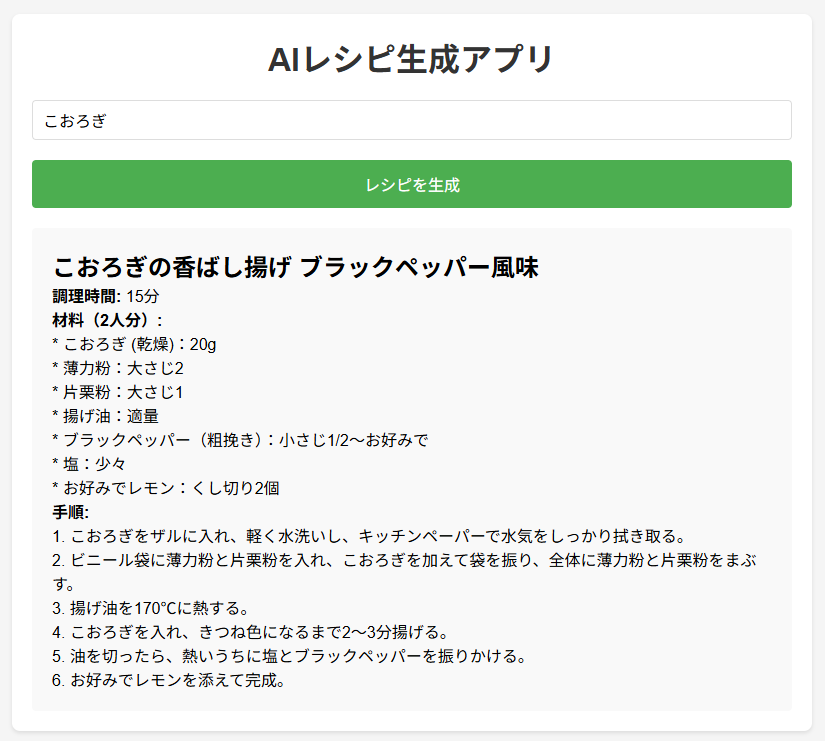はじめに
こんにちは!都内で細々とバックエンドエンジニアをしているRyoです。
今回は、FASTAPIとGoogleのGemini APIを使って、材料からレシピを自動生成するアプリを作ってみました!
「冷蔵庫に何があるか」と「何を作るか」の永遠の悩みを、AIの力で解決しちゃいましょう!![]()
この記事で学べること
- Google AI Studio(Gemini)の基本的な使い方
- 実用的なAIアプリケーションの作り方
- シンプルなフロントエンドの実装方法
開発環境の準備
1. プロジェクト構造
ai_recipe_assistant/
├── app/
│ ├── __init__.py
│ ├── main.py
│ ├── recipe_assistant.py
│ ├── prompts.py
│ └── static/
│ ├── index.html
│ ├── styles.css
│ └── script.js
├── .env
├── Dockerfile
├── docker-compose.yml
└── requirements.txt
2. Dockerfileの作成(Dockerfile)
FROM python:3.11-slim
WORKDIR /app
COPY requirements.txt .
RUN pip install --no-cache-dir -r requirements.txt
COPY . .
EXPOSE 8000
CMD ["uvicorn", "app.main:app", "--host", "0.0.0.0", "--port", "8000"]
3. requirements.txtの作成
必要なパッケージを記述します。
google-generativeai
python-dotenv
fastapi
uvicorn
4. Docker Composeの設定(docker-compose.yml)
services:
app:
build: .
ports:
- "8000:8000"
volumes:
- .:/app
env_file:
- .env
5. 環境変数の設定(.env)
Google AI StudioでAPIキーを取得して設定しましょう。
- まず、Google AI Studioにアクセスします。
- Googleアカウントでログインします。
- 画面右上の「Get API key」をクリックします。
- 「Create API key」をクリックして、新しいAPIキーを生成します。
- 生成されたAPIキーをコピーします。
次に、プロジェクトのルートディレクトリに.envファイルを作成し、以下のようにAPIキーを設定します。
# Google API Key
GOOGLE_API_KEY=あなたのAPIキー # ここにコピーしたAPIキーを貼り付けます
# AIモデル
AI_MODEL=gemini-2.0-flash-lite
![]() 注意点:
注意点:
- APIキーは秘密情報なので、GitHubなどに公開しないように注意してください
実装!! 
1. プロンプト(app/prompts.py)
AIにレシピを生成してもらうためのお願い文を作成します。
def create_recipe_prompt(ingredients: str) -> str:
return f"""
以下の材料を使用したレシピを提案してください:
{ingredients}
以下の形式で出力してください:
【料理名】
【調理時間】
【材料(2人分)】
【手順】
"""
2. メインクラス(app/recipe_assistant.py)
AIとのやり取りを担当するクラスを実装します。
import os
import google.generativeai as genai
from dotenv import load_dotenv
from app.prompts import create_recipe_prompt
import re
class RecipeAssistant:
def __init__(self):
load_dotenv()
genai.configure(api_key=os.getenv("GOOGLE_API_KEY"))
self.model = genai.GenerativeModel('gemini-pro')
def _parse_section(self, text: str, section_name: str) -> str:
pattern = f'【{section_name}】\s*(.*?)(?=【|$)'
match = re.search(pattern, text, re.DOTALL)
return match.group(1).strip() if match else ""
def _parse_list(self, text: str, section_name: str) -> list[str]:
section = self._parse_section(text, section_name)
return [line.strip() for line in section.split('\n') if line.strip()]
def get_recipe(self, ingredients: str) -> dict:
try:
prompt = create_recipe_prompt(ingredients)
response = self.model.generate_content(prompt)
text = response.text
return {
"dish_name": self._parse_section(text, "料理名"),
"cooking_time": self._parse_section(text, "調理時間"),
"ingredients": self._parse_list(text, "材料(2人分)"),
"steps": self._parse_list(text, "手順")
}
except Exception as e:
return {"error": str(e)}
3. APIエンドポイント(app/main.py)
FastAPIを使って、APIエンドポイントを実装します。
from fastapi import FastAPI, Query
from fastapi.staticfiles import StaticFiles
from fastapi.responses import FileResponse
from recipe_assistant import RecipeAssistant
app = FastAPI()
assistant = RecipeAssistant()
# 静的ファイルのマウント
app.mount("/static", StaticFiles(directory="app/static"), name="static")
@app.get("/")
async def read_root():
return FileResponse("app/static/index.html")
@app.post("/recipe")
async def generate_recipe(ingredients: str = Query(..., description="材料をカンマ区切りで入力")):
return assistant.get_recipe(ingredients)
4. フロントエンドの実装
4.1 HTMLファイル(app/static/index.html)
<!DOCTYPE html>
<html lang="ja">
<head>
<meta charset="UTF-8">
<meta name="viewport" content="width=device-width, initial-scale=1.0">
<title>AIレシピ生成アプリ</title>
<link rel="stylesheet" href="styles.css">
</head>
<body>
<div class="container">
<h1>AIレシピ生成アプリ</h1>
<div class="form-group">
<input type="text" id="ingredients" placeholder="材料を入力(例: 豚肉、玉ねぎ、人参)">
</div>
<button onclick="generateRecipe()" id="generateButton">レシピを生成</button>
<div class="loading" id="loading">
<div class="loading-spinner"></div>
<p>レシピを生成中...</p>
</div>
<div id="recipe" class="recipe"></div>
</div>
<script src="script.js"></script>
</body>
</html>
4.2 スタイルシート(app/static/styles.css)
:root {
--primary: #4CAF50;
--error: #ff4444;
--bg: #f5f5f5;
--card: #fff;
--text: #333;
}
li {
list-style-type: none;
}
* {
box-sizing: border-box;
margin: 0;
padding: 0;
}
body {
font-family: Arial, sans-serif;
background: var(--bg);
padding: 20px;
}
.container {
max-width: 800px;
margin: 0 auto;
background: var(--card);
padding: 20px;
border-radius: 8px;
box-shadow: 0 2px 4px rgba(0, 0, 0, 0.1);
}
h1 {
color: var(--text);
text-align: center;
margin-bottom: 20px;
}
.form-group {
margin-bottom: 20px;
}
input[type="text"] {
width: 100%;
padding: 10px;
border: 1px solid #ddd;
border-radius: 4px;
font-size: 16px;
}
button {
width: 100%;
padding: 12px;
background: var(--primary);
color: white;
border: none;
border-radius: 4px;
font-size: 16px;
cursor: pointer;
transition: background 0.3s;
}
button:hover {
background: #45a049;
}
button:disabled {
background: #ccc;
cursor: not-allowed;
}
.recipe,
.loading {
margin-top: 20px;
padding: 20px;
background: #f9f9f9;
border-radius: 4px;
}
.loading {
text-align: center;
display: none;
}
.loading-spinner {
width: 30px;
height: 30px;
border: 4px solid #f3f3f3;
border-top: 4px solid var(--primary);
border-radius: 50%;
margin: 0 auto 10px;
animation: spin 1s linear infinite;
}
.error {
color: var(--error);
}
@keyframes spin {
to {
transform: rotate(360deg);
}
}
4.3 JavaScriptファイル(app/static/script.js)
const el = {
ingredients: document.getElementById('ingredients'),
recipe: document.getElementById('recipe'),
loading: document.getElementById('loading'),
button: document.getElementById('generateButton')
};
const showLoading = () => {
el.loading.style.display = 'block';
el.recipe.style.display = 'none';
el.button.disabled = true;
};
const hideLoading = () => {
el.loading.style.display = 'none';
el.button.disabled = false;
};
const showError = msg => {
el.recipe.innerHTML = `<p class="error">${msg}</p>`;
el.recipe.style.display = 'block';
};
const showRecipe = data => {
el.recipe.innerHTML = `
<h2>${data.dish_name}</h2>
<p><strong>調理時間:</strong> ${data.cooking_time}</p>
<p><strong>材料(2人分):</strong></p>
<ul>${data.ingredients.map(ing => `<li>${ing}</li>`).join('')}</ul>
<p><strong>手順:</strong></p>
<ol>${data.steps.map(step => `<li>${step}</li>`).join('')}</ol>
`;
el.recipe.style.display = 'block';
};
const generateRecipe = async () => {
const ingredients = el.ingredients.value.trim();
if (!ingredients) return showError('材料を入力してください。');
showLoading();
try {
const res = await fetch(`/recipe?ingredients=${encodeURIComponent(ingredients)}`, { method: 'POST' });
const data = await res.json();
data.error ? showError(data.error) : showRecipe(data);
} catch (e) {
showError(`エラーが発生しました: ${e.message}`);
} finally {
hideLoading();
}
};
動作確認 
1. コンテナの起動
以下のコマンドをdocker-compose.ymlがあるディレクトリで実行します。
# ビルドして起動
docker-compose up --build -d
2. 実際に使ってみる!! 
ブラウザで http://localhost:8000 にアクセスする
材料を入力して「レシピを生成」ボタンをクリックすると、AIがレシピを生成します。
まとめ 
今回は、FASTAPIとGoogleのGemini APIを使って、材料からレシピを自動生成するアプリを作ってみました。
APIの使用量は無料なので、ぜひ作ってみてください!
最後に
このアプリを使って、冷蔵庫の余り物で何を作ろうか悩む時間を、美味しい料理を作る時間に変えましょう!
もし質問や改善点などありましたら、コメントで教えてください!
それでは、良いコーディングと美味しい料理を!![]()

